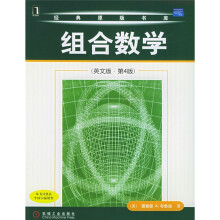组合数学(英文版)(第4版)

目 录
前言
Chapter 1. What Is Combinatorics?
1.1 Example.Perfect covers of chessboards
1.2 Example.Cutting a cube
1.3 Example.Magic squares
1.4 Example.The 4-color problem
1.5 Example.The problem of the 36 officers
1.6 Example.Shortest-route problem
1.7 Example.The game of Nim
1.8 Example
Chapter 2. The Pigeonhole Principle
2.1 Pigeonhole principle:Simple form
2.2 Pigeonhole principle:Strong form
2.3 A theorem of Ramsey
2.4 Exercises
Chapter 3. Permutations and Combinations
3.1 Four basic counting principles
3.2 Permutations of sets
3.3 Combinations of sets
3.4 Permutations of multisets
3.5 Combinations of multisets
3.6 Exercises
Chapter 4. Generating Permutations and Combinations
4.1 Generating permutations
4.2 Inversions in permutations
4.3 Inversions combinations
4.4 Generating r-combinations
4.5 Partial orders and equivalence relations
4.6 Exercises
Chapter 5. The Binomial Coefficients
5.1 Pascals formula
5.2 The binomial theorem
5.3 Identities
5.4 Unimodality of binomial coefficients
5.5 The multinomial theorem
5.6 Newtons binomial theorem
5.7 More on partially ordered sets
5.8 Exercises
Chapter 6. The Inclusion-Exclusion Principle and Applications
6.1 The inclusion-exclusion principle
6.2 Combinations with repetition
6.3 Derangements
6.4 Permutations with forbidden positions
6.5 Another for bidden position problem
6.6 Mobius inversion
6.7 Exercises
Chapter 7. Recurrence Relations and Generating Functions
Chatter 8. Special Counting Sequences
Chapter 9. Matchings in Bipartite Graphs
Chapter 10. Combinatorial designs
Chapter 11. Introduction to Graph Theory
Chapter 12. Digraphs and Networks
Chapter 1. What Is Combinatorics?
1.1 Example.Perfect covers of chessboards
1.2 Example.Cutting a cube
1.3 Example.Magic squares
1.4 Example.The 4-color problem
1.5 Example.The problem of the 36 officers
1.6 Example.Shortest-route problem
1.7 Example.The game of Nim
1.8 Example
Chapter 2. The Pigeonhole Principle
2.1 Pigeonhole principle:Simple form
2.2 Pigeonhole principle:Strong form
2.3 A theorem of Ramsey
2.4 Exercises
Chapter 3. Permutations and Combinations
3.1 Four basic counting principles
3.2 Permutations of sets
3.3 Combinations of sets
3.4 Permutations of multisets
3.5 Combinations of multisets
3.6 Exercises
Chapter 4. Generating Permutations and Combinations
4.1 Generating permutations
4.2 Inversions in permutations
4.3 Inversions combinations
4.4 Generating r-combinations
4.5 Partial orders and equivalence relations
4.6 Exercises
Chapter 5. The Binomial Coefficients
5.1 Pascals formula
5.2 The binomial theorem
5.3 Identities
5.4 Unimodality of binomial coefficients
5.5 The multinomial theorem
5.6 Newtons binomial theorem
5.7 More on partially ordered sets
5.8 Exercises
Chapter 6. The Inclusion-Exclusion Principle and Applications
6.1 The inclusion-exclusion principle
6.2 Combinations with repetition
6.3 Derangements
6.4 Permutations with forbidden positions
6.5 Another for bidden position problem
6.6 Mobius inversion
6.7 Exercises
Chapter 7. Recurrence Relations and Generating Functions
Chatter 8. Special Counting Sequences
Chapter 9. Matchings in Bipartite Graphs
Chapter 10. Combinatorial designs
Chapter 11. Introduction to Graph Theory
Chapter 12. Digraphs and Networks
比价列表
公众号、微信群
 缺书网
缺书网微信公众号
 扫码进群
扫码进群实时获取购书优惠





